
Home - Search - Browse - Alphabetic Index: 0- 1- 2- 3- 4- 5- 6- 7- 8- 9
A- B- C- D- E- F- G- H- I- J- K- L- M- N- O- P- Q- R- S- T- U- V- W- X- Y- Z
IMIS 1968
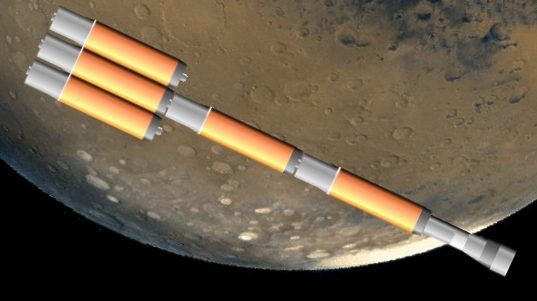
IMIS 1968
Integrated Manned Interplanetary Spacecraft, Boeing design for a Mars expedition using NERVA nuclear stages, 1968
Credit: © Mark Wade
AKA: Integrated Manned Interplanetary Spacecraft. Status: Study 1968. Thrust: 2,601.70 kN (584,885 lbf). Gross mass: 1,225,500 kg (2,701,700 lb). Unfuelled mass: 352,500 kg (777,100 lb). Specific impulse: 850 s. Height: 177.40 m (582.00 ft). Diameter: 10.00 m (32.00 ft).
The Integrated Manned Interplanetary Spacecraft represented the culmination of a decade of NASA studies and became the starting point when manned Mars studies would resume in the 1980's. The Boeing spacecraft for the Mars mission used five modular PPM Nerva nuclear thermal rocket stages to boost several unmanned probes, a manned MEM lander, a MM Mission Module crew compartment, and a biconic EEM Earth Entry Module for re-entry into the earth's atmosphere at the end of the mission. The modular, flexible IMIS design could accomplish 15 of the 20 mission opportunities to Mars and Venus in the 1975-1980 time period.
The MEM was that designed by North American for the Marshall Spaceflight Center in an October 1966-August 1967 study. This lander design was the first to incorporate the Mariner 4 findings on the tenuous nature of the Martian atmosphere.
Boeing used the Mars orbit rendezvous profile developed at NASA Lewis in 1959-1961. The spacecraft had the capability to fly all conjunction and opposition profile missions, with or without Venus swingby, in all but the worst Mars flight opportunities. Total development cost through the first two missions to Mars was estimated as $30 billion, 50% more than the Apollo program. If the start of full-scale development began in 1976, the first landing on Mars could be made in 1985-1986.
The following article summarizes the report in detail.
Manned Interplanetary Spacecraft
by Larry L Baker
Larry L Baker is a lead engineer with the Space Division, The Boeing Company, Kent, Washington
Appeared in the Northwest Professional Engineer, Summer/Fall 1968 Issue
The Boeing Company's Space Division recently completed its first funded study contract (NAS 1-6774) from NASA Langley entitled "Integrated Manned Interplanetary Spacecraft Concept Definition." The objective of this study was to design a space vehicle that could carry out a variety of manned missions to Venus and Mars between 1975 and 1990. (At present, of course. NASA has no plans for manned interplanetary flights.) Missions to Venus were to be orbiters and those to Mars, landers. Design or selection of the flight vehicle elements including the earth launch vehicle, the space propulsion stages, and the spacecraft elements (mission module, earth entry module, etc.) was left up to the Boeing project team.
Figure 1 shows some weights for a typical Mars mission. Reading the figure from left to right, the build-up of accumulated weight is in the reverse order of the mission sequence of events. Starting out at the earth surface, having completed a typical Mars mission, the original six-man crew has been returned with a few photographs of the Mars surface, and a 2000-lb sample of the planet itself. In order to return this "payload" into the earth's atmosphere, an earth re-entry module (EEM) must be provided. The cumulative weight has now increased to 17 000 lbs. A place for the crew to live and work in transit is provided by a mission module (MM), running the cumulative weight up to 110000 lbs. The spacecraft is now back in Mars orbit, and it is necessary to provide a Mars depart stage (MDS) which increases the accumulated weight to 500 000 lbs. From Mars orbit an element to perform the landing is required, so a Mars excursion module (MEM) is added and the weight is up to 630 000 lbs. To enter the Mars orbit a Mars capture stage (MCS) is provided, and the accumulated weight increases to 1 180 000 lbs. This Mars transit weight requires an earth depart stage (EDS) to leave earth orbit, and the accumulated weight is 86 000000 lbs. When this weight is compared to the original 2000 lbs it becomes evident that, as a result of very high energy requirements, there are very high leverage factors on these missions. As an example, the total accumulated change in speed to do this particular Mars mission is on the order of 90 000 ft/sec. This is compared with the Apollo vehicle which will perform a similar mission to the moon with an accumulated total required speed of about 60000 ft see or fifty percent less than the Mars mission.
Missions studied
Figure 2 shows sonic typical mission parameter variations. The first column lists the twenty Mars and Venus missions that were agreed upon by Boeing and NASA for investigation in this study. The missions are broken into various mission classes such as opposition, conjunction, and swingby for Mars, and short-stay and long-stay time mission to Venus. The numbers at the end of the mission designation indicate the year of earth departure. The only numbers shown on this table are the maximum and minimum values in each case. The velocity variations over this group of twenty missions are very large, and the mission times vary from 460 to 1040 days. The longest manned mission to date has been fourteen days in the Gemini vehicle. Earth entry velocity in Fig. 2 varies from 38 000 to 60 000 ft/sec. This compares with 25 000 ft/sec which have been achieved on the Gemini and Mercury systems and 36000 ft/sec which must be achieved with the Apollo command module. Earth launch vehicles
Earth launch vehicles were investigated which had payloads to low earth orbit, ranging from the Saturn V at 200 000 lbs, to post-Saturn in excess of 4 000 000 lbs. Study results showed that uprating the Saturn V by increasing its length and engine thrust and by adding small strap-on solid rocket motors increases its cost effectiveness. The larger post-Saturn launch vehicles have very high research and development costs. The selected ELV is a modification of the SI-C and SII stages with four 156-in. diameter, solid rocket motor strap-ons. Payload capability to low earth orbit with the four strap-ons is approximately 550 000 lbs. Payload capability with the core alone is approximately 300 000 lbs. Since the Sputnik I launch on October 4, 1957, the Russians and the United States have collectively launched more than eight hundred pounds into low earth orbit. Eight launches of this very large Saturn V-25(S)U Earth Launch Vehicle would orbit the total accumulated weight of all those payloads.
Entry, mission and excursion modules
The selected spacecraft which contains the three basic manned elements: the earth entry nodule (EEM). The mission module (MM) or crew compartment, and the Mars excursion module (MEM). The EEM is a biconic shape vehicle which has the capability to enter the earth's atmosphere at or greater than the 60000 ft/sec that is required. Its weight is a function of the earth entry velocity. The MM is a cylinder with four floor levels. One floor contains the experiments. A second floor provides a radiation shelter for the crew in the event a period of high solar radiation is encountered. The third floor is the control center, and the fourth floor is the living area. Total floor area is approximately 1400 sq ft, or about the size of a three-bedroom house. However, 50 000 lbs. Of equipment is also located in this crew compartment. When the floor area for this equipment is subtracted, the usable floor area for the crew is closer to 1000 sq ft. The six-man crew will be living in this "house" for periods up to three years. The mission module weight is a function of mission time. The MEM is a self-contained element which lands three of the six-man crew on the surface of Mars and returns them to the orbiting spacecraft. Space propulsion systems
The variety of systems studied includes chemical, nuclear, and aerobraking (for planet capture). In a nuclear system liquid hydrogen is heated in a reactor, and the hot gas is expanded through a nozzle for thrust. The nuclear system was selected over the chemical because of its higher performance (specific impulse approximately 850 see). The aerobraking scheme was considered to involve higher technical risks than the nuclear scheme. The objective of performing a variety of missions with one vehicle dictated that some degree of commonality be inherent in resolving the space propulsion design problem. In order to have a common propulsion system and utilize the earth launch vehicle to its greatest capacity, the nuclear propulsion module was sized such that when full of liquid hydrogen, its weight is approximately equal to the payload to orbit capability of the ELV (around 550 000 lbs).
These modules arc then stacked, as shown in Fig. 5, into a PM I stack or earth depart stage, a PM 2 planet capture stage, and a PM 3 planet depart stage. At mission start, the tanks are essentially full. As the earth orbit depart A V is performed, the possibility exists that not enough liquid hydrogen is contained in the first (PM I) stage to do the earth orbit depart. Provisions have been made, therefore, to transfer propellant from the PM 2 module back to the PM 1 module so that there is no need to add another PM 1 module. Similarly, when the Mars or Venus capture A V is attempted with PM 2, there may not be enough liquid hydrogen in the PM 2 module to perform the planet capture z~ V, and propellant is transferred from the PM 3 module back to PM 2. The propellant transfer scheme has removed the inherent ineffectiveness of a common tank system by providing the capability to use propellant in a high energy requirement stage and store it in a low energy requirement stage. The system is essentially one large storage tank with the advantage of being able to stage those inerts no longer required.
The final recommended primary propulsion module 33-ft diameter matches the upper diameter of the earth launch vehicle. The Nerva type nuclear engine develops a thrust of 200 000 lbs. The inner propellant tank is isolated from an outer shell which provides the two functions of carrying all the loads incurred in the system up to the burning of this stage and providing meteoroid protection for the tank. At engine ignition of this stage, this outer shell is jettisoned along with the aft interstage to minimize the accelerated mass. Note that the propulsion module inert weight (157 000 lbs) when added to the liquid hydrogen capacity of this tank (385 000 lbs) is approximately equal to the Saturn V-25(S)U earth launch vehicle capability to low earth orbit. The Boeing S-IC stage is the largest stage being built in the free world today, and probably the largest stage in the world. This nuclear propulsion module is the same diameter and 18 ft longer than the S-IC. Recalling the early 1960's when we observed the Mercury flights on television, the Mercury system was made up of an Atlas launch vehicle, the Mercury re-entry vehicle, and a tall abort tower on top of the Mercury capsule. This total stack is equal to a nine-story building in height. It would be possible to put four of these stacks of Atlas-Mercury escape tower inside one PM hydrogen tank.
The propulsion modules and the spacecraft when assembled in earth orbit will appear as shown in Fig. 7. Three propulsion modules are used in the PM I stage and one each in the PM 2 and PM 3 stages. This combination of modules maximizes the number of missions (of the original twenty) which can be performed in a cost effective manner. The small propulsion system shown in the aft interstage of the PM 2 stage is used for outbound midcourse corrections. Similarly there is a small propulsion stage in the back of the PM 3 interstage which is used for orbit trim in the planet orbit. There is also an inbound midcourse correction propulsion system within the spacecraft. These propulsion systems utilize space storable propellants. With this recommended space vehicle, the capability exists of performing fifteen of the original twenty missions shown in Fig. 2 with excess capability on twelve of these missions. Because of this excess capability, due to the common tank approach with propellant transfer, the system provides flexibility. For these twelve missions the possibility exists of providing additional experiments, probes, weight growth, an additional crewman or two, or a reduction in specific impulse.
Operations
Figure 8 shows the procedure for inserting this recommended space vehicle into earth orbit. The first launch is a Saturn V-25(S)U core with which the spacecraft is placed in orbit by itself. The second launch is a modified six-man Apollo logistics vehicle which is placed in orbit with a Saturn TB launch vehicle. This logistics vehicle brings up the manning and checkout crew and docks to the spacecraft. The third launch is a full Saturn V-25(S)U with a PM 3 module that docks to the back end of the spacecraft. The fourth launch is the PM 2 module. The center module of the PM 1 comes up next (fifth launch), docks backwards to the center module of PM 1 and swings around to fasten at the top as shown in Fig. 8. Similarly, the other side module on PM 1 (seventh launch), docks backwards and swings around to the other side. The final launch is another Saturn TB with a modified six-man Apollo logistic vehicle which brings up the mission crew, resupplies the spacecraft, and returns the manning and checkout crew back to the earth.
With the system assembled in orbit, the mission events sequence is as shown in Fig. 9. The first event is to jettison the PM 1 interstage and meteoroid shield. When the earth orbit depart delta-V is accomplished, PM 1 is jettisoned. Three outbound midcourse corrections (OBMC) are required on approach to the planet. The PM 2 interstage and shielding is jettisoned, the vehicle is turned around, and PM 2 is used to brake the space vehicle into a high planet orbit. The PM 2 stage is jettisoned and the orbit trim (OT) system is used to lower the orbit to approximately 540 nautical miles. After about a day, the Mars excursion module and the engineering probes are sent down to the Mars surface. After thirty days, the MEM returns to the mother vehicle, docks, the crew is transferred, and the module is jettisoned along with the PM 3 interstage and meteoroid shield. The PM 3 is fired for planet orbit depart and jettisoned. Three inbound midcourse corrections are required, and approximately a day prior to encounter with earth, the six-man crew transfers into the earth entry module. The EEM separates from the spacecraft and enters the earth's atmosphere.
Costs
Figure 10 provides a preliminary cost estimate of a program of this nature. The funding rate is shown versus years from go-ahead. The research and development stack includes both basic research and testing. This particular plot is for the accomplishment of two missions with departure dates as shown. The earliest departure date is almost twelve years from go-ahead. The total cost for performing two missions is approximately equal to thirty billion dollars. Thirty billion dollars may not sound overly expensive, when it is only about 50 percent more than was planned to be spent for the Apollo system. On the other hand, it would take a hundred people, whose average salary was fifteen thousand dollars a year, twenty thousand years to accumulate thirty billion dollars, Summary
This concept definition problem was very broad in scope and involved a wide range of very high energy requirements. If a version of Buck Roger's spaceship, or the Diet Smith Spacecoupe were expected, the study is disappointing. The final result is a brute force method of performing this mission because to date no other way is known. Even though the accomplishment of these missions is feasible, there are a great number of very complex problems that must be solved first. Some examples are long-duration subsystems (particularly environmental control and electrical power), long-term liquid hydrogen storage, high-velocity earth entry vehicle thermal protection, and earth orbital assembly techniques. The system is flexible, however, because of the excess payload capability for most of the missions. One fact that remains inflexible and constant: manned planetary exploration is going to be expensive.
IMIS 1968 Mission Summary:
- Summary: NASA Classic nuclear thermal rocket, modular spacecraft for manned interplanetary missions. Boeing study shown in detail; those by other contractors in same period were similar.
- Propulsion: Nuclear thermal
- Braking at Mars: propulsive
- Mission Type: opposition
- Split or All-Up: all up
- ISRU: no ISRU
- Launch Year: 1985
- Crew: 6
- Mars Surface payload-metric tons: 5
- Outbound time-days: 200
- Mars Stay Time-days: 30
- Return Time-days: 230
- Total Mission Time-days: 460
- Total Payload Required in Low Earth Orbit-metric tons: 1226
- Total Propellant Required-metric tons: 873
- Propellant Fraction: 0.71
- Mass per crew-metric tons: 204
- Launch Vehicle Payload to LEO-metric tons: 249
- Number of Launches Required to Assemble Payload in Low Earth Orbit: 6
- Launch Vehicle: Saturn V-25(S)U
Development Cost $: 30,000.000 million. Cost Notes: 1968 dollars, through the first two Mars missions. Crew Size: 6. Habitable Volume: 200.00 m3. Spacecraft delta v: 13,400 m/s (43,900 ft/sec).
Family: Mars Expeditions. Country: USA. Engines: Nerva-1. Spacecraft: MEM, EEM, MM, PPM. Propellants: Nuclear/LH2. Agency: Boeing. Bibliography: 253.
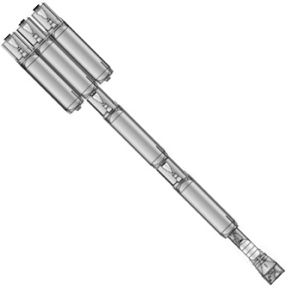 | IMIS 1968 Integrated Manned Interplanetary Spacecraft, Boeing design for a Mars expedition using NERVA nuclear stages, 1968, cutaway diagram Credit: © Mark Wade |
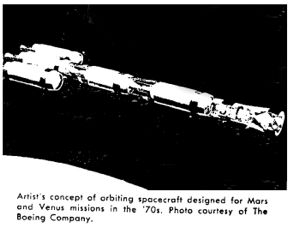 | IMIS 1968 IMIS Spacecraft Credit: Boeing |
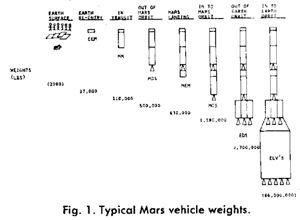 | IMIS 1968 IMIS Figure 1 Credit: Boeing |
 | IMIS 1968 Baker, Boeing Lead Engineer, IMIS |
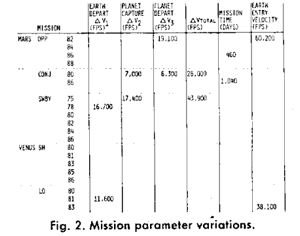 | IMIS 1968 IMIS Figure 2 Credit: Boeing |
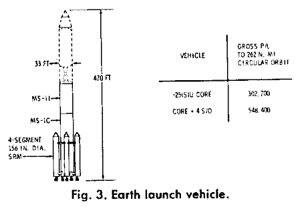 | IMIS 1968 IMIS Figure 3 Credit: Boeing |
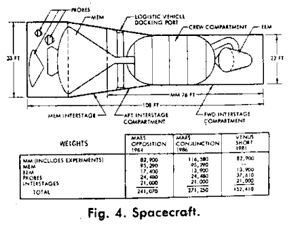 | IMIS 1968 IMIS Figure 4 Credit: Boeing |
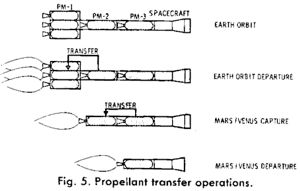 | IMIS 1968 IMIS Figure 5 Credit: Boeing |
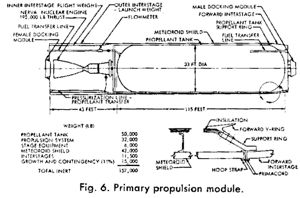 | IMIS 1968 IMIS Figure 6 Credit: Boeing |
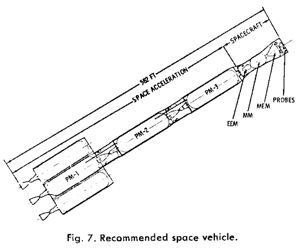 | IMIS 1968 IMIS Figure 7 Credit: Boeing |
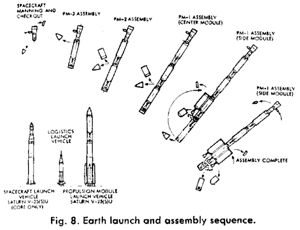 | IMIS 1968 IMIS Figure 8 Credit: Boeing |
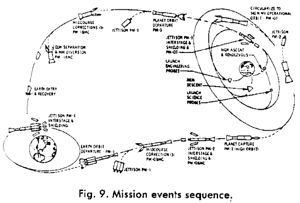 | IMIS 1968 IMIS Figure 9 Credit: Boeing |
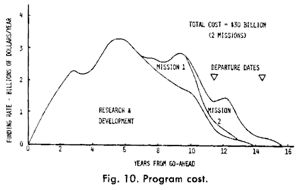 | IMIS 1968 IMIS Figure 10 Credit: Boeing |
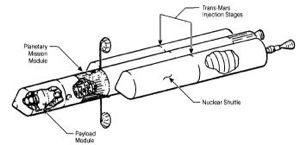 | Rockwell Mars 1969 Credit: NASA |
1966 April 15 - .
- NASA new manned space flight goal not using Apollo hardware - .
Nation: USA.
Related Persons: Gilruth,
Mueller.
Spacecraft: IMIS 1968,
Von Braun Mars Expedition - 1969.
NASA said to need a manned space flight goal other than "using Apollo hardware" - a Mars flyby or landing mission. MSC Director Robert R. Gilruth summarized Houston's position expressed during discussions with Associate Administrator for Manned Space Flight George E. Mueller two days earlier. Gilruth cited NASA s need for a manned space flight goal other than 'using Apollo hardware' (and suggested a Mars flyby or landing mission as an in-house focus for planning.) Also, he repeated his concern over the imbalance between AAP goals and resources, as well as the extent of engineering redesign and hardware modification that had been forced upon the project. Though expressing his and MSC's desire to contribute to and be a part of AAP, Gilruth voiced concern that 'the future of manned space flight . . . is in jeopardy because we do not have firm goals, and because the present approach appears to us to be technically unsound.'
Back to top of page
Home - Search - Browse - Alphabetic Index: 0- 1- 2- 3- 4- 5- 6- 7- 8- 9
A- B- C- D- E- F- G- H- I- J- K- L- M- N- O- P- Q- R- S- T- U- V- W- X- Y- Z
© 1997-2019 Mark Wade - Contact
© / Conditions for Use